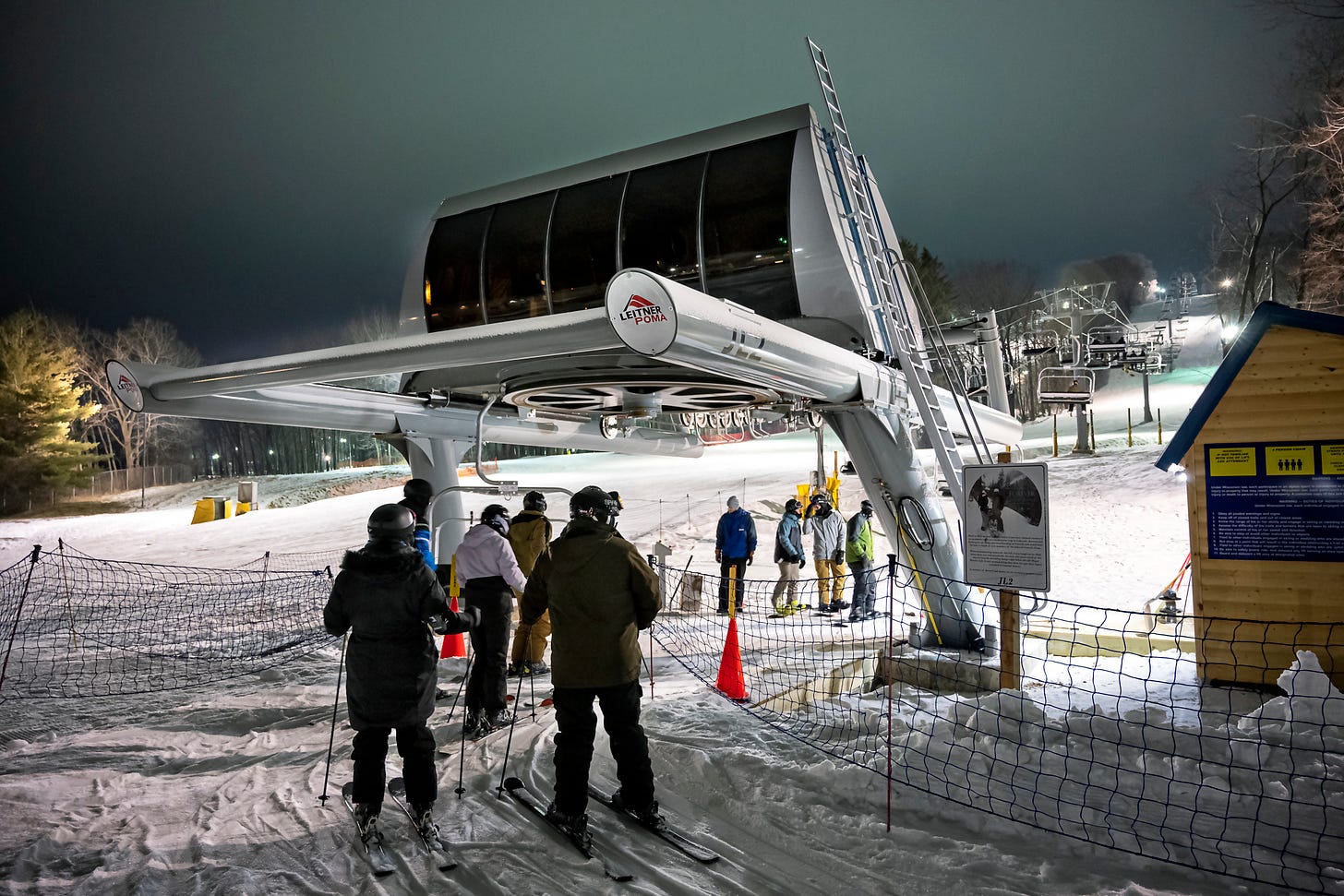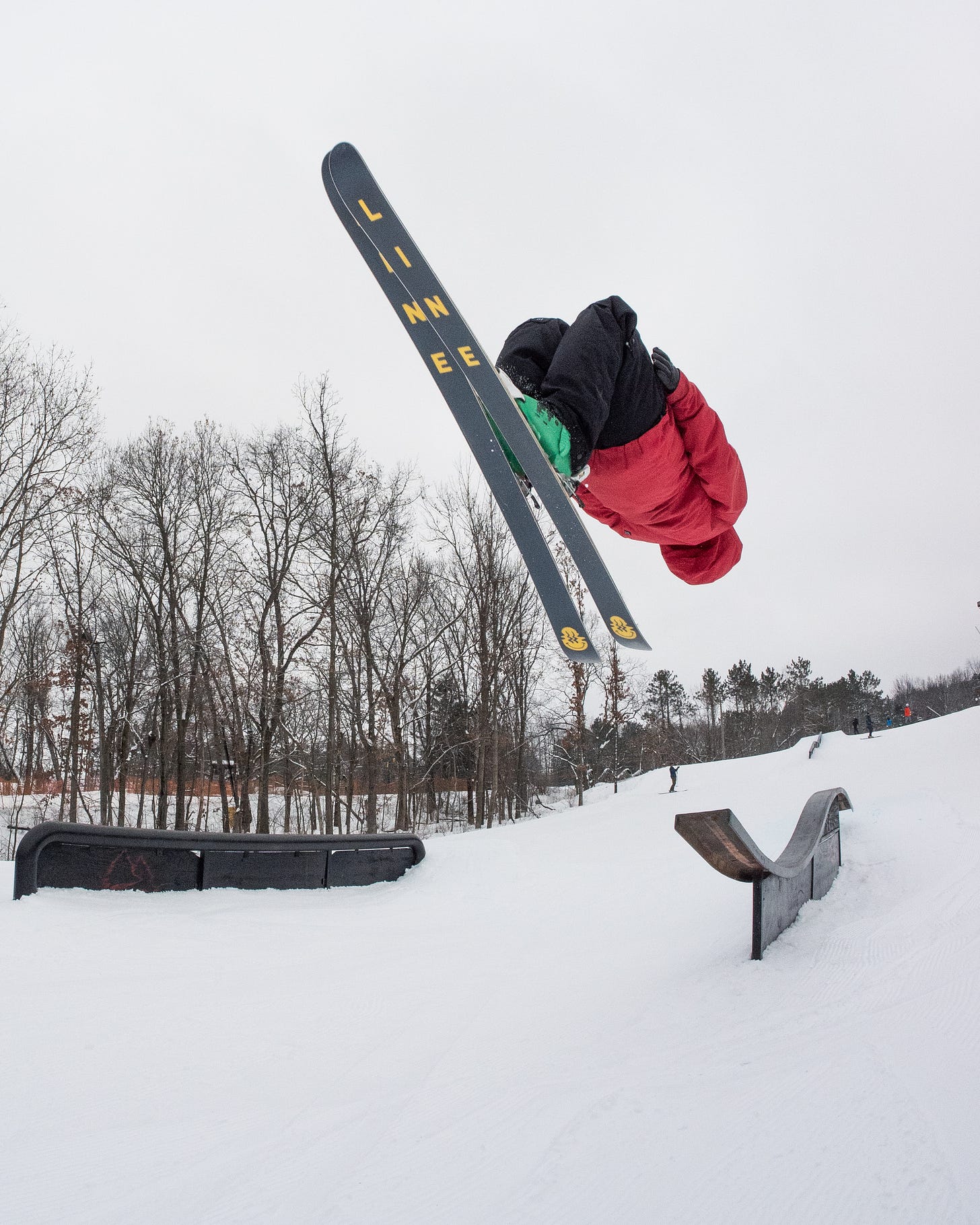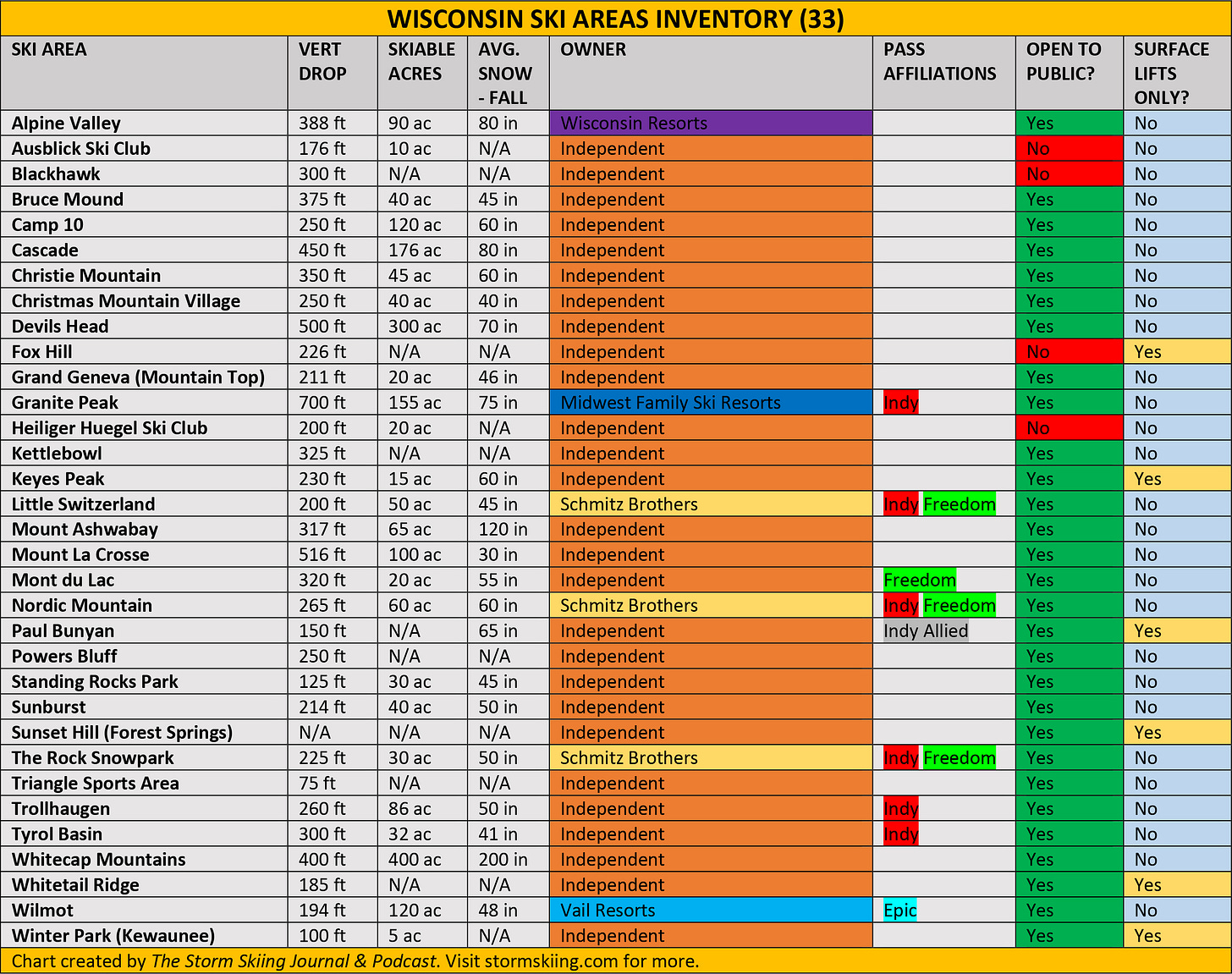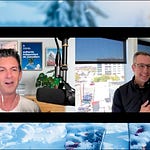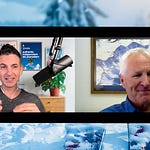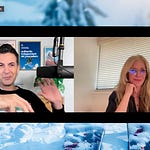Who
Matt Vohs, General Manager of Cascade Mountain, Wisconsin
Recorded on
October 10, 2023
About Cascade Mountain
Click here for a mountain stats overview
Owned by: The Walz family
Located in: Portage, Wisconsin
Year founded: 1962
Pass affiliations: None
Reciprocal partners: None
Closest neighboring ski areas: Devil’s Head (:20), Christmas Mountain Village (:30), Tyrol Basin (1:00)
Base elevation: 820 feet
Summit elevation: 1,280 feet
Vertical drop: 460 feet
Skiable Acres: 176
Average annual snowfall: 50-60 inches
Trail count: 48 (23% advanced, 40% intermediate, 37% beginner)
Lift count: 10 (2 high-speed quads, 3 fixed-grip quads, 1 triple, 2 doubles, 1 ropetow, 1 carpet – view Lift Blog’s inventory of Cascade’s lift fleet)
Why I interviewed him
Contrary to what you may imagine, Midwesterners do not pass their winters staring wistfully at the western horizon, daydreaming only of the Back Bowls and Wasatch tram rides. They’re not, God help us, New Yorkers. Because unlike the high-dollar Manhattanite with weeks booked at Deer Valley and Aspen, Midwesterners ski even when they’re not on vacation. Sure, they’ll tag that week in Summit County or Big Sky (driving there, most likely, from Grand Rapids or Cincinnati or Des Moines), but they’ll fill in the calendar in between. They’ll ski on weekends. They’ll ski after work. They’ll ski with their kids and with their buddies and with their cousins. They’ll ski in hunter orange and in Vikings jerseys and in knit caps of mysterious vintage. They’ll ski with a backpack full of High Life and a crockpot tucked beneath each arm and a pack of jerky in their coat pocket. “Want some,” they’ll offer as you meet them for the first time on the chairlift, a 55-year-old Hall double with no safety bar. “My buddy got an elk permit this year.”
They ski because it’s fun and they ski because it’s cold and they ski because winter is 16 months long. But mostly they ski because there are ski areas everywhere, and because they’re pretty affordable. Even Vail doesn’t break double digits at its Midwest bumps, with peak-day lift tickets reaching between $69 and $99 at the company’s 10 ski areas spread between Missouri and Ohio.
Because of this affordable density, the Midwest is still a stronghold for the blue-collar ski culture that’s been extinguished in large parts of the big-mountain West. You may find that notion offensive - that skiing, in this rustic form, could be more approachable. If so, you’re probably not from the Midwest. These people are hard to offend. Michigan-born Rabbit, AKA Eminem, channels this stubborn regional pride in 8 Mile’s closing rap battle, when he obliterates nemesis Papa Doc by flagrantly itemizing his flaws.
“I know everything he’s got to say against me” may as well be the mantra of the Midwest skier. In the U.S. ski universe, Colorad-Bro is Papa Doc, standing dumbfounded after Wisco Bro just turned his sword around on himself:
This guy ain’t no motherfucking MC
I know everything he’s got to say against me
My hill is short, It snows 30 inches per year
I do ski with a coffee Thermos filled with beer
My boys do ski in camouflage
I do ride Olin 210s I found in my Uncle Jack’s garage
I did hit an icy jump
And biff like a chump
And my last chairlift ride was 45 seconds long
I’m still standing here screaming “Damn let’s do it again!”
You can’t point out the idiosyncratic shortcomings of Midwest skiing better than a Midwest skier. They know. And they love the whole goddamn ball of bologna.
But that enthusiasm wouldn’t track if Wisconsin’s 33 ski areas were 33 hundred-foot ropetow bumps. As in any big ski state to its east or west, Wisco has a hierarchy, a half-dozen surface lift-only operations; a smattering of 200-footers orbiting Milwaukee; a few private clubs; and, at the top of the food chain, a handful of sprawling operations that can keep a family entertained for a weekend: Granite Peak, Whitecap, Devil’s Head, and Cascade. And, just as I’m working my way through the Wasatch and Vermont and Colorado by inviting the heads of those region’s ski areas onto the podcast, so I’m going to (do my best to) deliver conversations with the leaders of the big boys in the Upper Midwest. This is my sixth Wisconsin podcast, and my 15th focused on the Midwest overall (five in Michigan, one each in Indiana, Ohio, and South Dakota, plus my conversation with Midwest Family Ski Resorts head Charles Skinner – view them all here). I’ve also got a pair of Minnesota episodes (Lutsen and Buck Hill), and another Michigan (Snowriver) one booked over the coming months.
I don’t record these episodes just to annoy Colorado-Bro (though that is pretty funny), or because I’m hanging onto the Midwest ski areas that stoked my rabid obsession with skiing (though I am), or because the rest of the ski media has spent 75 years ignoring them (though they have). I do it because the Midwest has some damn good ski areas, run by some damn smart people, and they have a whole different perspective on what makes a good and interesting ski area. And finding those stories is kind of the whole point here.

What we talked about
Cascade’s season-opening plan; summer improvements; how much better snowmaking is getting, and how fast; improving the load area around Cindy Pop; Cascade’s unique immoveable neighbor; the funky fun Daisy mid-mountain parking lot; upgrading the Mogul Monster lift; why Cascade changed the name to “JL2”; Cascade’s “Midwest ski-town culture”; Devil’s Head; when I-94 is your driveway; why JL2 is a fixed-grip lift, even though it runs between two high-speed quads; other lift configurations Cascade considered for JL2; the dreaded icing issue that can murder high-speed lifts; reminiscing on old-school Cascade – “if the hill was open, we were here”; Christmas Mountain; a brief history of the Walz family’s ownership; a commitment to independence; whether slopeside lodging could ever be an option; which lifts could be next in line for upgrades; whether Cascade considered a midstation for Cindy Pop; the glory of high-speed ropetows and where Cascade may install another one; the summer of two lift installations; the neverending saga of Cascade’s expansion and what might happen next; the story behind the “Cindy Pop” and “B-Dub” lift names and various trail names; why Cindy Pop is a detachable lift and B-Dub is a fixed-grip, even though they went in the same summer; additional expansion opportunities; why Cascade hasn’t (and probably won’t), joined a multi-mountain ski pass; and Cascade’s best idea from Covid-era operations.
Why I thought that now was a good time for this interview
The National Ski Areas Association asked me to lead a panel of general managers at their annual convention in Savannah last spring. I offered them a half-dozen topics, and we settled on “megapass holdouts”: large (for their area), regionally important ski areas that could join the Indy Pass – and, in many cases, the Epic and Ikon passes – but have chosen not to. It’s a story I’d been meaning to write in the newsletter for a while, but had never gotten to.
We wanted nationwide representation. In the west, we locked in Mt. Baker CEO Gwyn Howat and Mt. Rose GM Greg Gavrilets. For the eastern rep, I tapped Laszlo Vajtay, owner of Plattekill, an 1,100-footer tucked less than three hours north of New York City (but nearly unknown to its mainstream skier populations). In the Midwest, Cascade was my first choice.
Why? Because it’s a bit of an outlier. While the Ikon Pass ignores the Midwest outside of Boyne’s two Michigan properties, opportunities for megapass membership are ample. Indy Pass has signed 32 partners in the region, and Vail has added 10 more to its Epic Pass. Five of the remainder are owned by an outfit called Wisconsin Resorts, which has combined them on its own multi-mountain pass. The model works here, is my point, and most of the region’s large ski areas have either opted into the Indy Pass, or been forced onto a different megapass by their owner. But not Cascade. Here is a mountain with a solid, modern lift fleet; a sprawling and varied trail network; and what amounts to its own interstate exit. This joint would not only sell Indy Passes – it would be a capable addition to Ikon or Epic, selling passes to voyaging locals in the same way that Camelback and Windham do in the East and Big Bear does in the West. And they know it.
But Cascade stands alone. No pass partnerships. No reciprocal deals. Just a mountain on its own, selling lift tickets. What a concept.
A core operating assumption of The Storm is that multi-mountain passes are, mostly, good for skiers and ski areas alike. But I have not made much of an effort to analyze counter-arguments that could challenge this belief. The Savannah panel was an exercise in doing exactly that. All four mountain leaders made compelling cases for pass independence. Since that conversation wasn’t recorded, however, I wanted to bring a more focused version of it to you. Here you go.
What I got wrong
I said that “I grew up skiing in Michigan” – that isn’t exactly correct. While I did grow up in Michigan, and that’s where I started skiing, I never skied until I was a teenager.
Why you should ski Cascade
Let’s say you decided to ski the top five ski areas in every ski state in America. That would automatically drop Cascade onto your list. Even in a state with 33 ski areas, Cascade easily climbs into the top five. It’s big. The terrain is varied. It’s well managed. The infrastructure is first-rate. And every single year, it gets better.
Yes, Cascade is consistent and deliberate in its lift and snowmaking upgrades, but no single change has improved the experience more than limiting lift ticket sales. This was a Covid-era change that the ski area stuck with, Vohs says, after realizing that giving a better experience to fewer skiers made more long-term business sense than jamming the parking lot to overfill every Saturday.
Every ski area in America is a work in progress. Watching The Godfather today is the same experience as when the film debuted in 1972. But if you haven’t skied Vail Mountain or Sun Valley or Stowe since that year, you’d arrive to an experience you scarcely recognized in 2023. Some ski areas, however, are more deliberate in crafting this evolving story. To some, time sort of happens, and they’re surprised to realize, one day, that their 1985 experience doesn’t appeal to a 21st century world. But others grab a handsaw and a screwdriver and carefully think through the long-term, neverending renovation of their dream home. Cascade is one of these, constantly, constantly sanding and shifting and shaping this thing that will never quite be finished.

Podcast Notes
On Wisconsin’s largest ski areas
I mentioned that Cascade was one of Wisconsin’s largest ski areas. Here’s a full state inventory for context:
On more efficient modern snowmaking
I mentioned a conversation I’d had with Joe VanderKelen, president of SMI Snow Makers, and how he’d discussed the efficiency of modern snowmaking. You can listen to that podcast here:
Podcast #111: SMI Snow Makers President Joe VanderKelen
Listen now (94 mins) | To support independent ski journalism, please consider becoming a free or paid subscriber. This podcast hit paid subscribers’ inboxes on Dec. 27. It dropped for free subscribers on Dec. 30. To receive future pods as soon as they’re live, please consider an upgrade to a paid subscription.
On naming the JL2 lift
When Cascade replaced the Mogul Monster lift last year, resort officials named the new fixed-grip quad on the same line “JL2.” That, Vohs tells us, is an honorarium to two Cascade locals killed in a Colorado avalanche in 2014: Justin Lentz and Jarrard Law. Per the Milwaukee Journal Sentinel on Feb. 16, 2014:
Two men from Portage were killed in a Colorado avalanche while skiing over the weekend.
Justin Lentz, 32, and Jarrad Law died when they and five other skiers were swept away by an avalanche late Saturday afternoon, friends and family told Madison television station WISC-TV (Channel 3.)
The avalanche occurred at an elevation of about 11,000 feet near Independence Pass, roughly 120 miles southwest of Denver.
The two skiers were found at the top of the avalanche, said Susan Matthews, spokeswoman for the Lake County Office of Emergency Management.
"The skiers were equipped with avalanche beacons, which assisted search and rescue crews in locating them," she said.
She said authorities believe the seven skiers triggered the slide. Officials found the bodies of Lentz and Law Sunday afternoon but did not release their names.
One of Lentz's family members told WISC-TV that the family was notified Saturday night. Lentz was a Portage High School graduate who was in Colorado on a skiing trip. A friend said Law had worked at Cascade Mountain and was an avid skier.
WKOW captured the scene at the JL2 lift’s opening this past January:
It was a bittersweet moment for those at Cascade Mountain as visitors took a ride on a new ski lift named in honor of two late skiers.
When it came time to name the new ski lift at Cascade Mountain in Portage, crews at the resort said there was only option that seemed fitting.
"We tossed around the idea of naming it after a couple of just really awesome guys who grew up skiing and snowboarding here," said Evan Walz, who is the Inside Operations Manager for Cascade Mountain.
The name they landed on was JL2. It's in honor of Jarrard Law and Justin Lentz.
"[I] wanted to cry," Justin Lentz's mother, Connie Heitke, said. "Because I knew that people were still thinking of them and love them as much as when it first happened."
Law and Lentz lost their lives to an avalanche while on a backcountry trip in Colorado in February 2014. Heitke said it has been hard but said it's the support from friends and family that helps her get through.
"[I] still miss him awfully a lot. He was my first. It's coming around and now that I can feel that it was okay because he used to enjoy life," she said.
Seeing people gather for the ribbon cutting of the ski lift's grand opening, Heitke said is a fabulous feeling.
"He [Justin] would have been grabbing my head and shaking my head and shaking me screaming and yelling and hollering just like he did," she said. "Jarrard would have just been sitting over there really calm with a smile on his face enjoying watching Justin."
From Lentz’s obituary:
Justin T. Lentz, age 32, of Sun Prairie, died on Saturday, February 15, 2014 as the result of a skiing accident in Twin Lakes, Colorado.
Justin was born on August 7, 1981 in Portage, the son of Robert and Connie (Heitke) Lentz. He graduated from Portage High School in 2000. He had worked at Staff Electric in Madison since 2005. Justin loved skiing, snowboarding, fishing, hiking, mountain biking, and making his weekends better than everyone else’s year.
From Law’s obituary:
Jarrard Leigh Law, 34, of Portage, formerly of Carroll County, died tragically while skiing in Colorado Saturday, Feb. 15, 2014.
He was born Dec. 6, 1979, in Freeport, to Joan (Getz) and Robert Law.
Jarrard was baptized at St. Peter’s Lutheran Church in Savanna and confirmed at Bethlehem Lutheran Church in Portage.
He was a 1998 graduate of Portage High School and earned a degree in computer information systems from Madison Area Technical College.
For the past 12 years, he was employed by CESA 5 working as a computer technician for the Necedah Area School District.
Jarrard was a member of Bethlehem Lutheran Church serving as an usher and communion assistant.
He enjoyed skiing, biking, hiking and many other outdoor activities.
On Devil’s Head
I’ve long had a low-grade obsession with ski areas that sit near one another. Despite drawing from identical or very similar weather systems, terrain features, and population bases, they ski, look, and feel like completely different entities. Think A-Basin/Keystone or Sugarbush/Mad River Glen – neighbors that exist, it can seem, in different universes.
Many versions of this dot the Midwest, with perhaps the most well-known being Nub’s Nob/The Highlands, an independent/Boyne Resorts duo that face one another across a Michigan backroad. How different are they? Both ski areas built new lifts this summer. The Highlands removed three Riblet triples and replaced them with one Doppelmayr D-Line bubble six-pack, a chairlift that probably cost more than the Detroit Lions. Nub’s Nob, meanwhile, replaced a Riblet fixed-grip quad with… a Skytrac fixed-grip quad. “High-speed chairlifts at Nub’s Nob just don’t make sense,” GM Ben Doornbos underscored in a video announcing the replacement:
Wisconsin’s version of this is Cascade and Devil’s Head, which sit 14 road miles apart. While both count similar vertical drops and skiable acreage totals, Devil’s Head, like Nub’s, relies solely on fixed-grip lifts. It’s a bit more backwoods, a bit less visible than Cascade, which is parked like a sentinel over the interstate. Vohs and I talk a bit about the relationship between the two ski areas. Here’s a visual of Devil’s Head for reference:
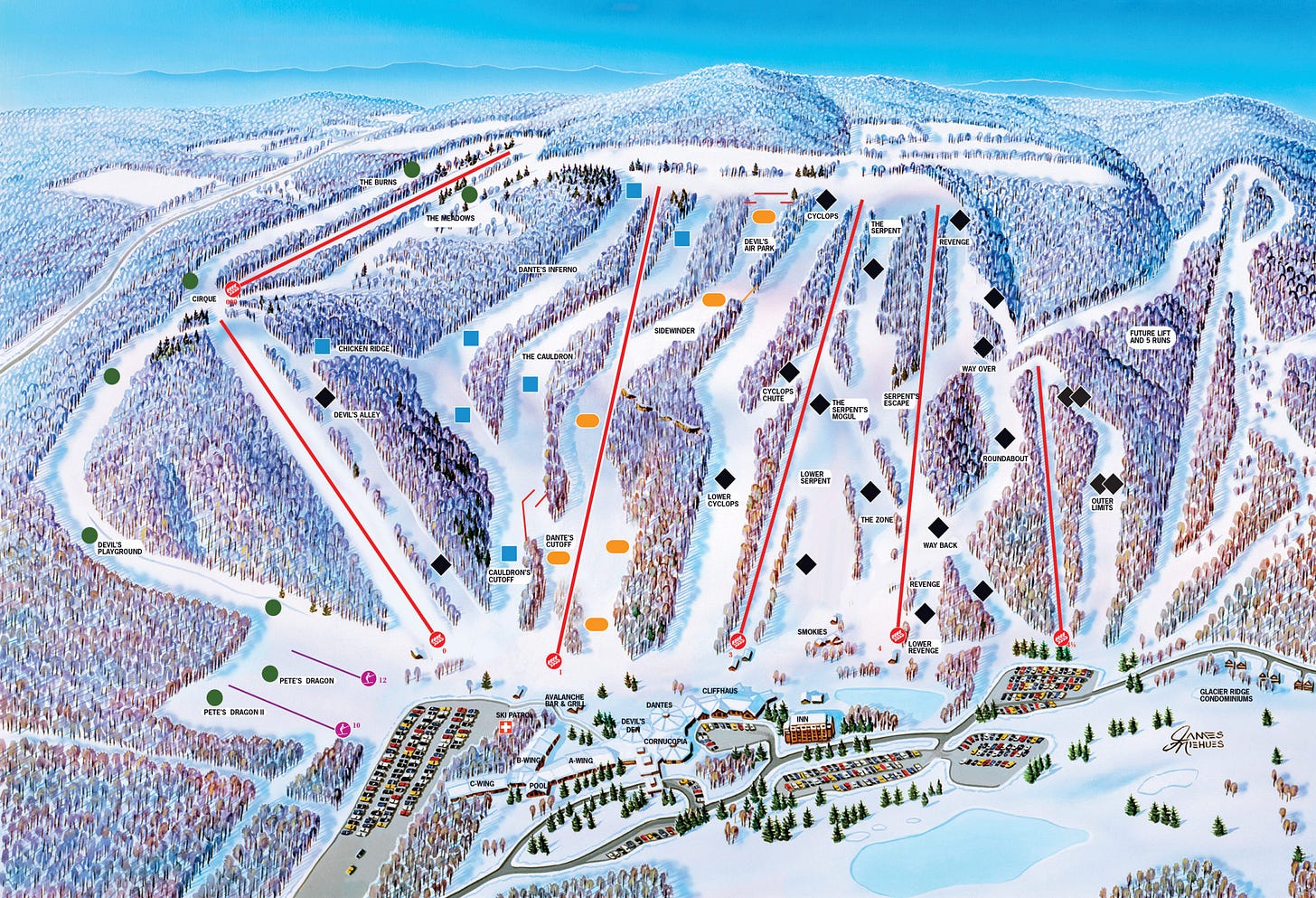
On Christmas Mountain
Vohs spent some time managing Christmas Mountain, 22 miles down the interstate. He refers to it as, “a very small operation.” The place is more of an amenity for the attached resort than a standalone ski area meant to compete with Cascade or Devil’s Head. It’s around 200 vertical feet served by a quad and a handletow:

On the capacity differences between fixed-grip and high-speed lifts
Cascade runs four top-to-bottom quads: two detachables and two fixed-grips. Vohs and I discuss what went into deciding which lift to install for each of these lines. Detachable quads, it turns out, are about twice as expensive to install and far more expensive to maintain, and – this is hard to really appreciate – don’t move any more skiers per hour than a fixed-grip quad. Don’t believe it? Check this excellent summary from Midwest Skiers:
You can also read the summary here.
On high-speed ropetows
I’m going to go ahead and keep proselytizing on the utility and efficiency of high-speed ropetows until every ski area in America realizes that they need like eight of them. Look at these things go (this one is at Mount Ski Gull in Minnesota):
On Cascade’s expansion and Google Maps
Many years ago, Cascade cut a half dozen or so top-to-bottom trails skier’s right of the traditional resort footprint. Were this anywhere other than Cascade, skiers may have barely noticed, but since the terrain rises directly off the interstate, well, they did. Cascade finally strung the B-Dub lift up to serve roughly half the terrain in 2016, but, as you can see on Google Maps, a clutch of trails still awaits lift service:

So what’s the plan? Vohs tells us in the podcast.
The Storm publishes year-round, and guarantees 100 articles per year. This is article 90/100 in 2023, and number 476 since launching on Oct. 13, 2019. Want to send feedback? Reply to this email and I will answer (unless you sound insane, or, more likely, I just get busy). You can also email skiing@substack.com.





